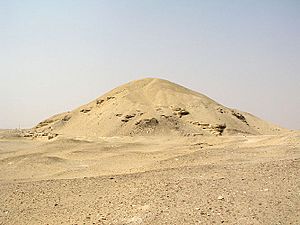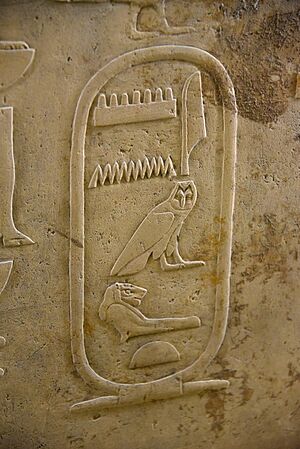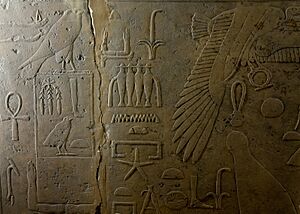Amenemhat I facts for kids
- See Amenemhat, for other individuals with this name.
Quick facts for kids Amenemhat I |
|
|---|---|
| Ammenemes I | |

Relief of Amenemhat I from his pyramid complex at El-Lisht
|
|
| Pharaoh | |
| Reign | 29 years according to the Turin Canon but at least 30 years, in the 20th century BC. (Twelfth Dynasty) |
| Predecessor | Mentuhotep IV |
| Successor | Senusret I |
| Consort | Neferitatjenen |
| Children | Senusret I, Neferu III, Neferusherit, Kayet |
| Father | Senusret |
| Mother | Neferet |
| Burial | Pyramid at el-Lisht |
Amenemhat I (meaning 'Amun is at the forefront') was an important pharaoh of ancient Egypt. He was the first king of the Twelfth Dynasty during the Middle Kingdom. His reign helped bring stability back to Egypt after a difficult period.
Amenemhat I was likely the same person as a powerful official named Amenemhat. This official worked for the previous pharaoh, Mentuhotep IV. It's thought that Amenemhat I might have taken over from Mentuhotep IV. Some historians believe he overthrew him, but there's no clear proof. They might have even ruled together for a short time.
Amenemhat I was not born into a royal family. His parents were Senusret and Nefert. To make his rule seem more legitimate, he used special writings and building styles. For example, he brought back the pyramid-style tombs, like those from the 6th Dynasty. His mother was from a region in Upper Egypt called Ta-Seti. Many experts now think his mother might have been from Nubia.
Amenemhat I moved the capital city from Thebes to a new place called Itjtawy. He was buried in a pyramid at el-Lisht. Sadly, he may have been assassinated.
Contents
Family and Background
His Family
Amenemhat I's parents were Senusret and Nefret. They were not part of the royal family. His mother, Nefret, is mentioned on an offering table found near his pyramid. This table calls her 'king's mother'. His father, Senusret, is mentioned on a stone block and was called 'god's father'.
His Link to Mentuhotep IV
It's not fully clear how Amenemhat I was connected to the pharaoh before him, Mentuhotep IV. He might have been the powerful official (called a vizier) who served Mentuhotep IV. This vizier is mentioned in old writings from Wadi Hammamat. These writings describe two amazing events: a gazelle giving birth on a special stone and a sudden rainstorm that filled a dry well. Some historians think these stories were meant to show that Amenemhat I was chosen by the gods.
There's also a bowl found with both kings' names on it. Some experts think this means they ruled together for a while. This idea is called a coregency. A coregency is when two pharaohs rule at the same time. This would have helped Amenemhat I gain power. Other experts believe the bowl just shows that Amenemhat I respected Mentuhotep IV. There were also other people who wanted to be king around this time.
His Wife and Children
Amenemhat I likely had one wife named Neferitatjenen. We know about her from a small statue of her son, Senusret I. The statue said, 'King Senusret born to King Amenemhat and born of the king's mother Neferitatjenen'. This statue was lost a long time ago.
Amenemhat I had one known son, who became the next pharaoh, Senusret I. He also had three daughters: Neferu III, Neferusherit, and Kayet. Neferu III is mentioned in an ancient story called the Story of Sinuhe. She was also the wife of Senusret I.
Early Years as King
There are signs that Amenemhat I's early time as king was not easy. There might have been political problems. Old writings mention naval battles where one of Amenemhat I's allies, Khnumhotep I, helped win victories. Later, Khnumhotep became an important local governor. He started a family line of governors in that area.
Khnumhotep's writings also talk about military actions against people from Asia and Nubia. This shows that Amenemhat I worked to protect Egypt's borders.
His Royal Name
Amenemhat I's royal name, Wehemmesu, means "renaissance" or "rebirth". This name was a nod to the Old Kingdom period. The kings of the Twelfth Dynasty wanted to bring back the great culture and traditions of the Old Kingdom. This included building pyramids and using older art styles.
During this time, the idea of the king as a god was also promoted. This helped bring back a strong, central government after a period of less control.
His Pyramid

Amenemhat I built his pyramid at El-Lisht. Its ancient Egyptian name meant 'Cult places of Amenemhat's appearance'. The pyramid was built with rough limestone blocks. The spaces between the blocks were filled with sand, dirt, and mudbricks. Interestingly, some of the blocks used had carvings on them that were taken from older monuments of the Old Kingdom. The outside of the pyramid was covered with fine limestone blocks.
The pyramid was about 84 meters (276 feet) long at its base and stood about 55 to 58 meters (180-190 feet) tall. Because of the way it was built and the materials used, the pyramid is now a ruined mound, only about 20 meters (66 feet) high. Grave robbers also caused a lot of damage. The choice to use cheaper materials might have been for practical reasons.
In front of the pyramid, on its east side, was a special temple called a mortuary temple. This temple had its own name, 'High [rises up] Amenemhat's beauty'. This was a new idea, as older temples usually shared the pyramid's name. The temple was built on a lower level than the pyramid and was smaller than Old Kingdom temples. Not much of the temple remains today. It seems the temple was rebuilt later by his son, Senusret I.
Underneath the pyramid, there was a hidden entrance from a chapel on the north side. This entrance led to a long corridor. The corridor was lined with pink granite and blocked with stones. It led to a square room with a shaft in the middle. This shaft went down to the burial chamber. However, this chamber is now filled with groundwater and has never been explored.
His Assassination
Two ancient writings from the end of Amenemhat I's reign tell us about his death. One is called the Instructions of Amenemhat. It's written as if the dead king is giving advice to his son in a dream. In this text, he warns his son not to trust his guards too much. He then describes how he was killed:
"I was asleep upon my bed... I awoke to fighting, and found that it was an attack of the bodyguard."
This passage suggests that Amenemhat I was killed by his own royal guards. This happened while his son and co-ruler, Senusret I, was away leading a military campaign.
Another famous Egyptian story, the Story of Sinuhe, also talks about this event. It says:
"Year 30... the king... went aloft to heaven... whilst the Residence was hushed, hearts were in mourning... His Majesty had sent an army to the land of the Tjemeh (Libyans), his eldest son as the captain thereof... And the Companions of the Palace sent... to acquaint the king's son concerning the position that had arisen in the Royal Apartments..."
This story confirms that Senusret I was away when his father died. Messengers quickly told Senusret I what had happened, and he rushed back to the capital.
Succession and Co-rule
Amenemhat I is believed to be the first Egyptian king to share his rule with his son, Senusret I. This is called a coregency. A special stone from Abydos shows dates from both kings' reigns. It's dated to Amenemhat I's 30th year and Senusret I's 10th year. This means Senusret I became co-ruler in Amenemhat I's 20th year. This shared rule helped make sure the transfer of power was smooth.
Important Officials
Not many officials from Amenemhat I's time are known. One important official was the vizier Ipi. A vizier was a very high-ranking government official, like a prime minister. Ipi held many important jobs, including treasurer and royal seal-bearer. Another vizier from this time was Intefiqer.
Two treasurers, Ipi (a different one) and Rehuerdjersen, also served under Amenemhat I. Two high stewards, Meketre and Sobeknakht, were also important figures in his government.
In Modern Stories
Naguib Mahfouz, a famous Egyptian writer who won the Nobel Prize, included Amenemhat I in one of his stories. This story, "Awdat Sinuhi" (later translated as "The Return of Sinuhe"), was published in 1941. It's based on the ancient "Story of Sinuhe" but adds new details. Mahfouz also wrote about Amenemhat I in his book "Facing the Throne," where ancient Egyptian gods judge the country's rulers.
See Also
- Twelfth Dynasty of Egypt family tree
- List of Egyptian pyramids
- List of megalithic sites



